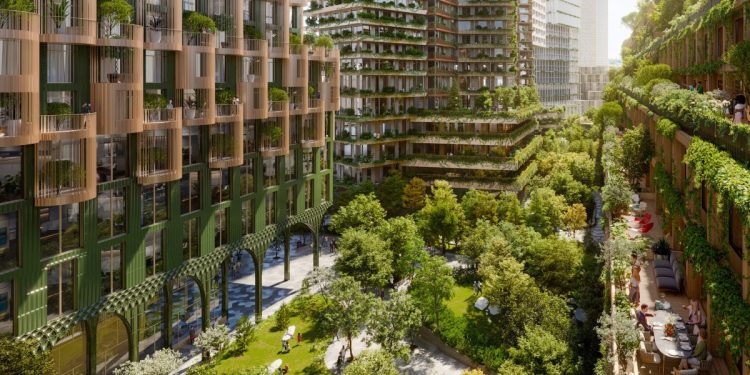Most Quayside watchers have a hard time believing that covid was the real reason for ending the project. Sidewalk Labs never really painted a compelling picture of the place it hoped to build.
Quayside 2.0
The new Waterfront Toronto project has clearly learned from the past. Renderings of the new plans for Quayside—call it Quayside 2.0—released earlier this year show trees and greenery sprouting from every possible balcony and outcropping, with nary an autonomous vehicle or drone in site. The project’s highly accomplished design team—led by Alison Brooks, a Canadian architect based in London; the renowned Ghanaian-British architect David Adjaye; Matthew Hickey, a Mohawk architect from the Six Nations First Nation; and the Danish firm Henning Larsen—all speak of this new corner of Canada’s largest city not as a techno-utopia but as a bucolic retreat.
In every way, Quayside 2.0 promotes the notion that an urban neighborhood can be a hybrid of the natural and the manmade. The project boldly suggests that we now want our cities to be green, both metaphorically and literally—the renderings are so loaded with trees that they suggest foliage is a new form of architectural ornament. In the promotional video for the project, Adjaye, known for his design of the Smithsonian Museum of African American History, cites the “importance of human life, plant life, and the natural world.” The pendulum has swung back toward Howard’s garden city: Quayside 2022 is a conspicuous disavowal not only of the 2017 proposal but of the smart city concept itself.
To some extent, this retreat to nature reflects the changing times, as society has gone from a place of techno-optimism (think: Steve Jobs introducing the iPhone) to a place of skepticism, scarred by data collection scandals, misinformation, online harassment, and outright techno-fraud. Sure, the tech industry has made life more productive over the past two decades, but has it made it better? Sidewalk never had an answer to this.
“To me it’s a wonderful ending because we didn’t end up with a big mistake,” says Jennifer Keesmaat, former chief planner for Toronto, who advised the Ministry of Infrastructure on how to set this next iteration up for success. She’s enthusiastic about the rethought plan for the area: “If you look at what we’re doing now on that site, it’s classic city building with a 21st-century twist, which means it’s a carbon-neutral community. It’s a totally electrified community. It’s a community that prioritizes affordable housing, because we have an affordable-housing crisis in our city. It’s a community that has a strong emphasis on green space and urban agriculture and urban farming. Are those things that are derived from Sidewalk’s proposal? Not really.”
Source by www.technologyreview.com

























